www.johntyman.com/peru/04.html
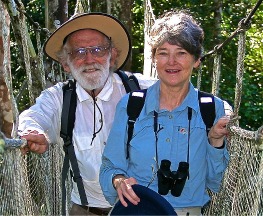 |
CULTURES IN CONTEXT PERU The Incas and Prehistoric Cultures II: MOCHE CULTURE 2.3: Religious Beliefs and Practices |
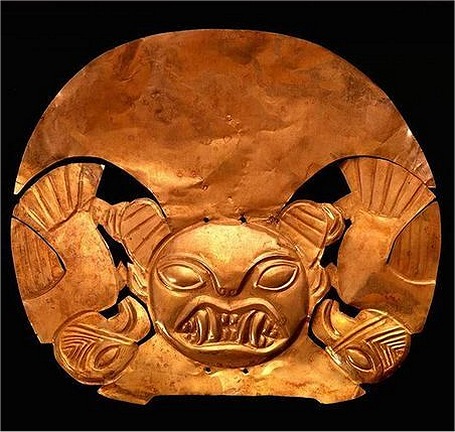
026. Al Paec the Creator or sky god and Si the moon goddess are typically depicted in Moche art with ferocious fangs, a jaguar headdress, and snake earrings. Both were believed to dwell in the highest mountains. Human sacrifices, especially of prisoners of war, were offered to appease them, and their blood was offered in ritual goblets. |
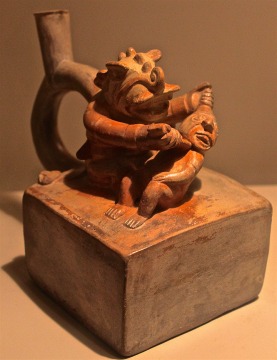
027. Another deity who frequently appears in Moche art is the half-man, half-jaguar Decapitator god, so-called because he is often represented holding a vicious looking sacrificial knife (tumi) in one hand and the severed head of a sacrificial victim in the other. This god may also be depicted as a gigantic spider ready to suck the life-blood from his victims. |
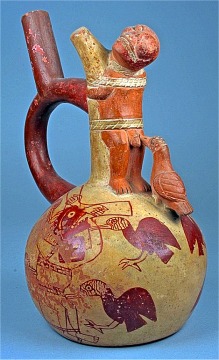
028. Human sacrifice played a significant part in Moche religious practices. These rites appear to have involved the elite as key actors in a spectacle of costumed participants, monumental settings, torture, and the ritual consumption of blood. (Torture by birds: photo courtesy Rowan Millar) |
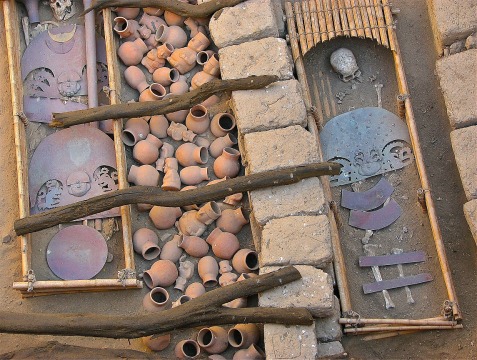
029. At Sipan, a short distance inland from the coast in the valley of the Lambayeque River, the graves of a Moche lord and his attendants dramatically illustrate their funeral practices. |
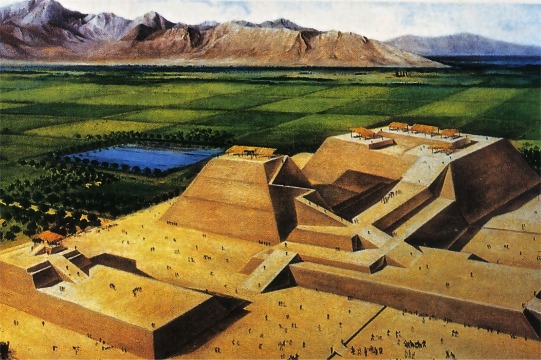
030. The monument at Sipan consisted of two large pyramidal structures aligned from east to west, with a lower funerary platform, or royal mausoleum, on the western side (in the foreground here). (Hypothetical reconstruction of the Sipan Sanctuary: from “Prehispanic Cultures of Peru” by Justo Caceres Macedo) |
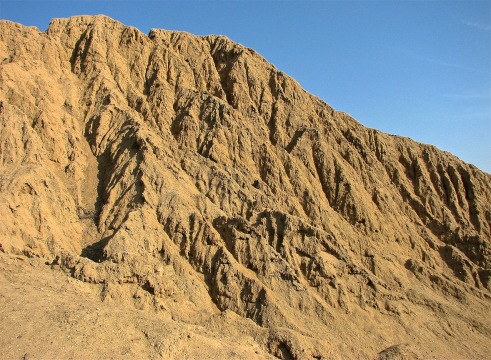
031. The pyramids, though much eroded, still tower over the surrounding countryside, with an average height of 36 metres. |
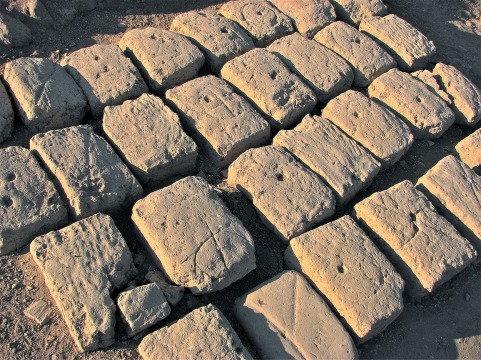
032. The pyramids were built of adobe bricks by commoners in lieu of tax. The bricks were made in moulds but they were smoothed afterwards and they bore geometric designs that identified their makers. |
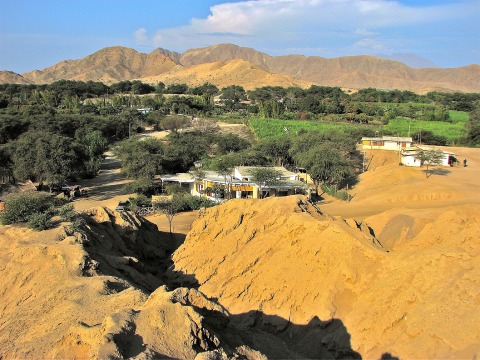
033. The Sipan mausoleum housed 12 tombs, of leaders, priests, warriors and retainers. It is considered to be among the richest burial sites found in the western hemisphere, and certainly the richest tomb in Peru to have escaped looting. (Site of the Mausoleum and related administration buildings.) |
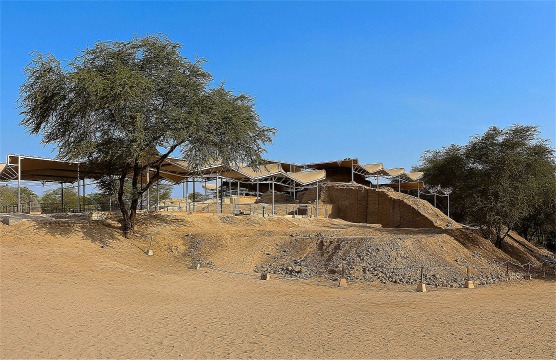
034.The tombs are now protected from the rain, which so eroded the pyramids. (Excavation area.) |
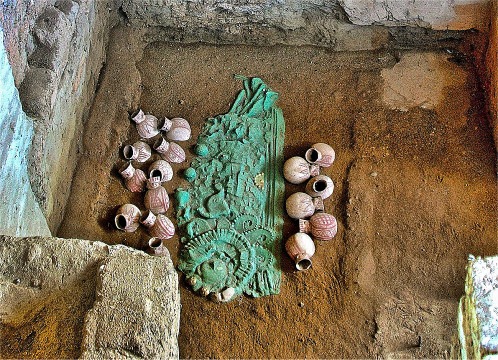
035. Among the 12 tombs in the mausoleum were the graves of four important persons … that of the Lord of Sipan himself, of the Priest, the Old Lord of Sipan, and the Warrior. They were all buried with sacrificed attendants. (Grave of the so-called “Old Lord”: photo courtesy Bob Coates) |
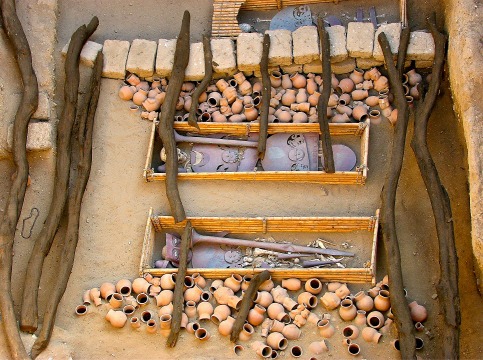
036. The people buried with their lord must have been those closest to him. Their ornaments indicate their rank and the specific functions they had in life: and it was only natural that they accompany their lord when he died. (Graves of priest/warrior.) |
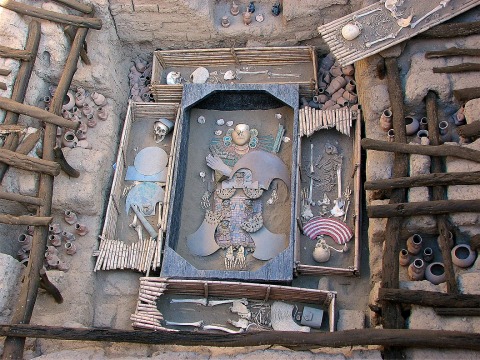
037.The Lord of Sipan lay in a wooden coffin, joined together by copper hooks. He was surrounded by three concubines, two warriors and a guard (outside this photo) whose feet had been amputated so he could not leave his post. The Lord’s body was covered in offerings … 450 of them … objects made of gold, silver, turquoise, copper, seashells, semi-precious stones, and decorated textiles (which disintegrated long ago). (Reconstruction of Lord’s burial chamber.) |
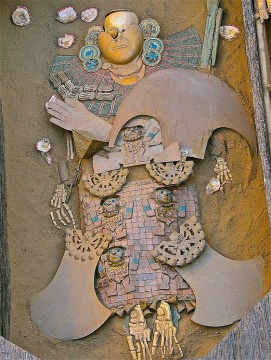
038. His jewellery included a gold crown and face covering; three gold and turquoise ear spools on each side of his head; gold nose pieces; a pectoral of red, white and green shell beads; elaborate body coverings, some of gold and turquoise; and a necklace of gold and silver peanut shells (a new more productive type of peanut having been introduced during his reign). |
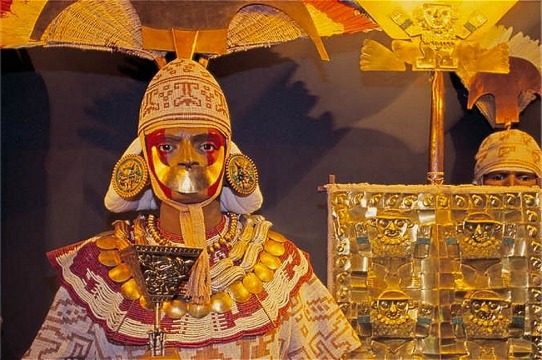
039. Artefacts found in the tomb revealed that ritual bondage, torture, and decapitation of prisoners had occurred here, and that human sacrifice played a significant part in Moche religious practices. These rites appear to have involved the elite as key actors in a spectacle of costumed participants, with rites of ancestral renewal and agricultural fertility. (From a dramatic re-enactment.) |
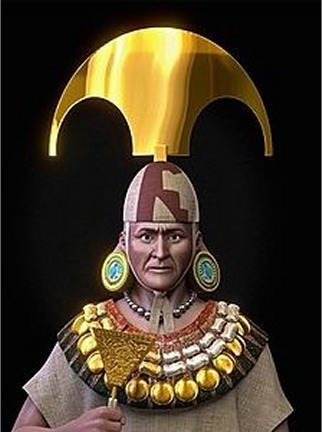
040. The Moche “state” suffered at the hands of the nearby Wari kingdom, and its collapse was also the result of devastating floods followed by droughts, one of which lasted for 30 years in the sixth century. Most Moche sites were abandoned around AD600-700. (Forensic Reconstruction of the face of the Lord of Sipan, by Cicero Moraes) |
![]()
Text and photos by John Tyman
Intended for Educational Use Only.
Contact Dr. John Tyman at johntyman2@gmail.com
for information regarding public or commercial
use.
![]()
www.hillmanweb.com
Photo processing, Web page layout, formatting
and hosting by
William
Hillman ~ Brandon, Manitoba ~ Canada